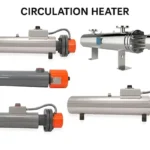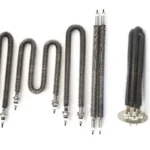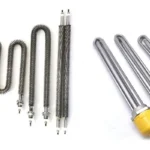The Definitive Guide to Custom Cartridge Heaters: Performance, Precision, and Reliability
In countless industrial processes, from plastics manufacturing to medical device sterilization, the cartridge heater is a small but mighty component. Its reliability is often the bedrock of production efficiency. This guide serves as a complete engineering resource, designed to help you diagnose common heater failures and specify a custom solution that delivers maximum performance and eliminates costly downtime.

Why Standard Heaters Fail: The Hidden Costs of an "Off-the-Shelf" Solution
When a standard cartridge heater fails, the cost of the component itself is trivial compared to the expense of lost production, scrapped materials, and maintenance labor. Understanding the root causes of these failures is the first step toward building a more reliable thermal system.
The #1 Cause of Failure: How a Poor Fit Leads to Premature Burnout
The single most common reason for premature cartridge heater failure is an improper fit between the heater and its surrounding bore. Even a tiny air gap acts as a powerful insulator, trapping heat within the heater and preventing it from efficiently transferring to your tool or platen. To compensate, the internal resistance wire must operate at a drastically higher temperature than it was designed for, leading to rapid degradation and a swift burnout. A precise fit is not a luxury; it is the foundation of a long and reliable service life.

Silent Sabotage: Moisture, Contamination, and Internal Short Circuits
The high-purity Magnesium Oxide (MgO) used as an electrical insulator inside a cartridge heater is hygroscopic—it readily absorbs moisture from the air. During operation, as the heater cools, it can draw in humid air or contaminants like hydraulic oil or cutting fluids. Once inside, this contamination compromises the MgO's dielectric strength, creating a path for a short circuit that leads to immediate failure. This makes unsealed, standard heaters extremely vulnerable in environments with frequent washdowns or oil mists.

When Leads Give Out: Understanding Termination and Mechanical Stress Failures
The point where the lead wires exit the heater is a critical stress point. Standard lead insulation can become brittle and fail when exposed to high ambient temperatures. Furthermore, constant flexing, vibration, or abrasion against sharp edges inside machinery can easily damage the wires, causing a failure that shuts down your entire process. A robust lead configuration is essential for mechanical durability.

The Frustration of Seizure: Why Standard Heaters Get Stuck and How It Damages Tooling
After many hours at high temperatures, a standard heater's metal sheath can undergo oxidation and expand, effectively welding it into the bore. This "bore seizure" turns a simple replacement into a costly, time-consuming maintenance nightmare. The heater often must be drilled out, a process that risks permanently damaging expensive molds, dies, and other tooling. The cost of this labor and potential tool damage can be astronomical.
The Strategic Advantage of Customization: Solving Your Toughest Heating Challenges
A custom-engineered cartridge heater is not just a component; it's a strategic solution designed to eliminate the specific failure modes you experience. By tailoring the design to your application, you can move from a reactive cycle of replacement to a proactive state of reliability.
Achieving Perfect Temperature Uniformity with Distributed Wattage
Standard heaters produce even heat along their length. But in applications like long sealing bars or platens, significant heat is lost at the ends. This creates cool spots and inconsistent product quality. A custom heater with a distributed wattage profile is wound to deliver more power to the ends and less to the middle, perfectly counteracting heat loss and creating a truly uniform temperature across the entire working surface.
Designing for Durability in Harsh Environments (Moisture, Vibration, Corrosion)
A custom heater can be built to survive where standard heaters fail. We can incorporate features like moisture-resistant epoxy or hermetic ceramic-to-metal seals to protect against contamination. For high-vibration or abrasive environments, we can specify leads with a protective stainless steel braid or flexible armor casing. For corrosive applications, we can select advanced sheath materials like Incoloy® or 316 Stainless Steel.
The Power of Precision: Integrated Thermocouples for Ultimate Control
Accurate temperature control requires accurate feedback. In many compact designs, there is no space to mount a separate sensor. A custom heater can be built with an integrated Type J or K thermocouple positioned directly inside the sheath, providing the fastest, most accurate temperature reading possible for superior process control.
Beyond the Cylinder: Custom Shapes and Form Factors
While most cartridge heaters are cylindrical, some applications require a different approach. We can engineer custom form factors, such as square or rectangular cartridge heaters, to provide more uniform heating for flat surfaces like platens, eliminating the hot and cold spots that can occur with round heaters.
How to Specify Your Custom Cartridge Heater: A Step-by-Step Engineering Guide
This section provides the framework to translate your application needs into a robust technical specification. Follow these steps to design a heater that is built to last.
Step 1: Defining Your Operating Parameters (Temperature, Material, Environment)
Before any calculations, gather the essential data about your process. What is the maximum operating temperature required? What material are you heating (e.g., steel, aluminum, water)? Will the heater be exposed to moisture, chemicals, or significant vibration? This information forms the foundation of all subsequent design choices.
Step 2: Calculating Wattage and Selecting the Right Watt Density
First, calculate the total wattage needed to heat your mass in the required time, accounting for heat losses. Once you have the total wattage, you must ensure the watt density (watts per square inch of the heater's surface) is appropriate for your application. Too high a watt density will cause the heater to fail prematurely. We can help you determine the optimal balance for long life and fast heat-up.
Unsure about your heat loss calculations? Consult an Elekheat engineer for a free thermal analysis. Our experts can help you determine the precise wattage your application needs.
Step 3: Nailing the Dimensions: Diameter, Length, and Fit Tolerance
Measure the bore diameter and length precisely. As discussed, the fit is critical. A proper fit is typically 0.002" to 0.004" smaller than the bore diameter. We manufacture our custom heaters to extremely tight tolerances to ensure optimal performance.
| Nominal Bore Diameter (in) | Recommended Reamed Hole Size (in) |
|---|---|
| 1/4" | 0.250" (+0.001 / -0.000) |
| 3/8" | 0.375" (+0.001 / -0.000) |
| 1/2" | 0.500" (+0.001 / -0.000) |
| 5/8" | 0.625" (+0.001 / -0.000) |
| 3/4" | 0.750" (+0.001 / -0.000) |
Step 4: Choosing the Right Materials (Sheath, Leads, Seals)
The right materials are essential for longevity. The sheath material depends on temperature and corrosive factors, while lead insulation must be rated for the ambient temperature at the heater exit.
| Material | Max Temperature | Best For |
|---|---|---|
| 304 Stainless Steel | 1200°F (650°C) | General purpose, good corrosion resistance. |
| 316 Stainless Steel | 1200°F (650°C) | Superior corrosion resistance for medical/food grade. |
| Incoloy® 800/840 | 1600°F (870°C) | High-temperature applications and resistance to oxidation. |
Step 5: Selecting Terminations and Mounting Options for Your Machine
How the heater is mounted and how the leads are routed is critical for reliability. We offer a wide range of terminations, from simple straight leads to right-angle exits with protective armor, as well as mounting options like flanges and threaded NPT fittings.

Partnering with Elekheat: Your Expert in Custom Thermal Solutions
We are more than a manufacturer; we are an engineering partner dedicated to solving your most complex heating challenges. Our process is designed to deliver a solution that provides lasting value.
Our Engineering and Design Process
Our process is collaborative. It begins with a detailed consultation with our application engineers to fully understand your needs. We then move to design and validation, ensuring every parameter is optimized for your system before manufacturing begins.
Quality You Can Trust: Global Standards and Advanced Manufacturing
All Elekheat custom heaters are proudly manufactured in the CN under a strict ISO 9001 quality management system. Every heater undergoes rigorous testing to ensure it meets our high standards for performance and safety, with UL® and CSA recognized components available.
Fast Lead Times to Keep Your Production on Schedule
We understand that downtime is costly. Our streamlined manufacturing process is optimized to provide some of the fastest lead times in the industry for custom-engineered heaters, helping you get your production line back up and running quickly.
Frequently Asked Questions (FAQ) about Custom Cartridge Heaters
A properly specified and installed custom heater can last for years. Lifespan is primarily determined by the fit, watt density, and operating temperature. Premature failure is almost always a sign of a design or installation issue.
The best prevention is a proper initial fit. For high-temperature applications, using an anti-seize coating during installation can help. For guaranteed easy removal, a custom split-sheath heater design is the ultimate solution.
High watt density heaters can produce more heat from a smaller size but require an excellent fit and good thermal conductivity to prevent burnout. Low watt density heaters are more forgiving of fit and are used in applications where the material being heated cannot absorb heat quickly.
Yes, but it will only produce 1/4 of its rated power (wattage). However, you should NEVER use a 120V heater on a 240V circuit, as it will produce 4 times the power and fail almost instantly.
To get a fast and accurate quote, please provide the diameter, length, voltage, wattage, lead length, and any special requirements like internal thermocouples or specific lead protection.
Start Your Custom Heater Design Today
Ready to move beyond standard components and build a more reliable system? Our team is here to help you design the perfect custom cartridge heater for your application. Choose the path that's right for you:





